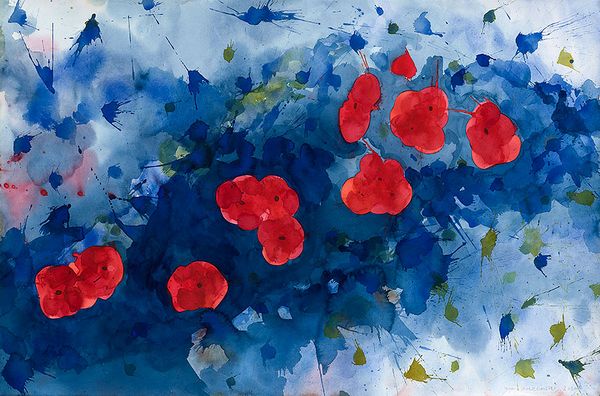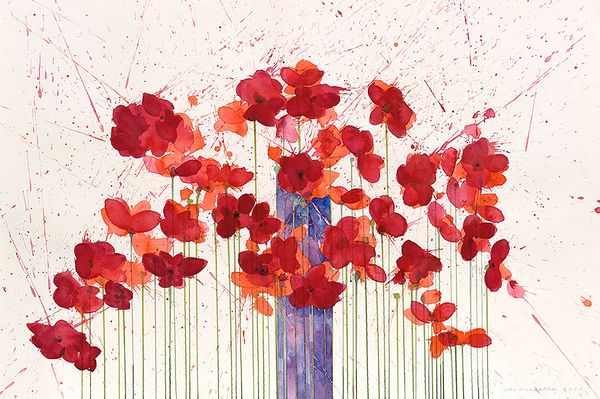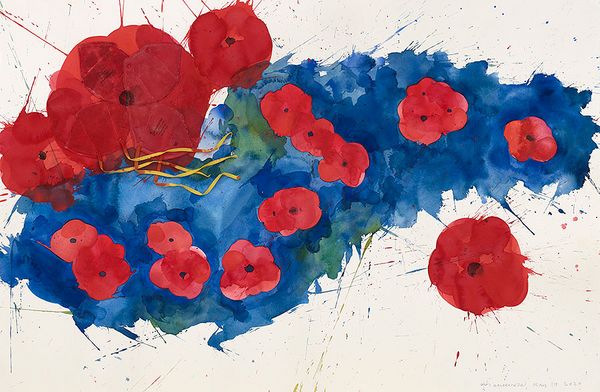Brian Clarke, Vesper 453, 2020.
Phillips X and HENI are pleased to present Brian Clarke: Vespers—a spectacular exhibition of works by architectural artist and painter Brian Clarke. This debut exhibition of Clarke’s extensive series of watercolours on paper is on view to the public at 30 Berkeley Square from 5 August to 10 September 2021. The entire Vespers series will be made available in a limited duration sale on the HENI Leviathan website, which drops on the morning of Wednesday, September 1 throughout the last week of the exhibition, ending on Friday, September 10.
CHEYENNE WESTPHAL: To begin, tell us about the evolution of your work in such diverse media as stained glass to collage. How did you arrive at the 'Vespers' and this present moment?
BRIAN CLARKE: There's been a tradition in Western art since at least the 1970s where artists concentrate on a single theme. That focused pursuit of a single idea has produced some extraordinary things, but I belong to a different kind of artists. I used to be embarrassed by it, to some degree, and think it was a weakness that I stylistically tablehop, and that I would spend 15 years being a kind of Neo constructivist, and working with formal analytical abstraction. And then it suddenly dawned on me that the reservoir of material available to an artist to express himself was so immense, so infinite, and that the idea that you would restrict yourself to a single limited vocabulary, just suddenly seemed absurd. I started looking at Picasso and Gerhard Richter as paradigmatic examples of the way that you have to move between ideas in order to express the multiplicity of ideas that occur to you through your life. As Reyner Banham famously said, in order to prove you've got a mind you have to occasionally change it.
I had an odd kind of childhood, in that, when I was 12, it was noticed that I had some kind of talent or a great interest in visual art. I was—with my parents’ permission—removed from normal education and sent as a young student to art school in Oldham. There were a few art schools dotted about England in those days, born out of a tradition formed by Ruskin and William Morris, where instead of working-class kids going down the coal mine or into the cotton mills, they were trained in visual arts. It was wonderful for me because I can't imagine doing anything else. The idea of working in the city, in an office, in a factory or in a bank, or God forbid, as a soldier, terrifies me.

Brian Clarke, Vesper 409, 2019.
CW: When did your “sneaky romance” with flowers, as you’ve called it, begin?
BC: When I was 15, I went to an art school in North Devon, and something happened—it’s a very simple little thing but it was meaningful to me. As I was walking down the hill from the lodgings I saw wild primroses in the middle of the lane, and I'd never seen wildflowers before. I mean, I'd seen flowers in shops and in people's houses, and in the cemetery, where I’d go see my grandad every Sunday with my aunties. But wild flowers: this beautiful kind of gentle, soft yellow peppered amongst that almost vulgar green of Devonian grass. They had a really big impact, made me cry almost, you know. So flowers have played a part in my artistic psyche since I was very young. No matter what subject matter or pursuit I'm making visually, whether I'm working on a large-scale architectural project or whether I'm painting clearly, completely abstract works, flowers have always fed into that thinking process.
Poppies have a particular delicacy of memory for me, because I was great friends with Linda McCartney in the late `70s, early `80s, and the `90s. There was a little shop close by to where Paul [McCartney] lived in the country, in Sussex, called Jensen's, and they used to sell poppy seeds. We always used to buy a few and drive back up to their house, open the window and then just throw the seeds out. And then some months later you'd be driving up to these poppies, just from this simple little act.
Each one of these pictures is, in my mind, a prayer.
CW: You’ve compared flowers with the nature of glass—could you expand on that idea?
BC: Poppies are the most fragile, the most delicate and vulnerable of flowers. The petal is so thin that it transmits light. Light doesn't fall on it and bangs off in a reflective nature, like it does with most flowers; it passes through it. And, of course, that makes it in my mind, very like stained glass. When I started painting Vespers in Seville in 2019, I was consciously pursuing the transparent nature of poppies, and wanting the watercolor to spread so that the light would fall through the color and bounce back off the white paper.
I've always been kind of castigated by art dealers I've worked with—not all of them but some of them—for doing stained glass because they say it confuses people. How are we meant to sell it? How are we meant to exhibit it? Of course, being an artist, if somebody tells you that you can't do something, the first thing you start thinking about is how you can do it better and more. I call them Vespers, which comes from the idea of prayer. I'm not a religious person, but I do believe that by thinking affectionately, warmly, and empathetically about other people, you add something good to the world. Each one of these pictures is, in my mind, a prayer. When I'm painting them. I don't imagine them being exhibited. But I do imagine them communicating love. I'm not really a soppy person. But when it comes to making art, I am. I like to communicate.

Brian Clarke, Vesper 447, 2020.
CW: How did the motifs and traditions of heraldry influence the project?
BC: I come from the urban, working class, industrial north of England. And in this funny art school system that I was brought up in, we learned objective drawing, life drawing, mixing pigment, perspective—and heraldry. I think it was the first time that I appreciated what abstract art really was. It became clear that you could create a series of semaphores or signals that conveyed very particular and specific messages, even if they were not figurative. A lot of early mediaeval 11th, 12th, 13th-century stained glass is heraldic in nature.
There's this old idea, and it's still propagated, that stained glass is the poor man's Bible, that it was a way of conveying the narrative of the Gospels to the peasant. Well, insofar as I'm aware, and I am not a social historian, 12th century peasants didn't have binoculars. You cannot see what those stories are telling you from 30 meters below. What you are conscious of is the abstraction of color, and nothing more than an entirely heraldic stained glass window was capable of conveying the power of abstraction in color. So I will always find heraldry an intoxicating abstraction, not just of color and symbol, but of almost a ladder, of which you can climb to another worldly experience.
CW: You’ve talked about the importance of recognizing what accidents to keep and what accidents to lose during the creative process. What were some of those accidents in this project?
BC: Most artists have a sense of architecture so that when they compose a picture, they give themselves a structure they can climb and move around in order to get their message across. But what they've got to be really acutely sensitive to is nature putting itself in and making an accident, making something else. And if suddenly there's a splash or drip or an unexpected combination of colors that make another unexpected color, you've got to pursue that drip. If you follow the drip, you’ll rarely go wrong.
The last couple of days I've been looking at Giotto’s paintings in Assisi. And there are certain moments in the developments of those paintings where you can see unexpected events occurred and he had the genius to embrace those events—and not only treasure them but encourage them. And you can see it particularly in Modernism and contemporary art, it’s almost a signature of our modernity that we allow accidents to interfere. Picasso talked about becoming a drainpipe; that was the moment when he was really at his best, when he ceased to be conscious of the self, of the place, or of the moment. Accident is maybe not quite the right word, it's the word I use but it's maybe not quite that what it is. It's when the artist becomes one with the nature of being who he or she is, that's when really great art happens. Art is a communicative phenomenon, like a vesper, a moment, a profound desire to quietly, privately, discreetly transfer from ourselves something good to someone else.

Brian Clarke, Vesper 453 (detail), 2020.
CW: How did the project evolve as you continued working throughout the pandemic? What new elements did you want to explore?
BC: There are a number of the works that actually contain face masks collaged into the poppies. Right at the beginning of the pandemic, the face masks were rather clumsy things, they weren't these elegant, lightweight, stylish things designed by Stella McCartney or something. They looked actually floral in their design—and they were there because they had to be there, they needed to be there. It's become in retrospect something very real about that moment in our shared history. There are some of the works where you see rather more menacing dark things that I'm not quite sure what they are, they look a bit like butterflies, but they're black and maybe they represent the pandemic.
I knew a number of people who lost their lives as a result of COVID. Like everyone else, I was worried for the people I love and the people I don't know or love but feel a natural human empathy toward. There are a number of the works with newspaper pages—I suppose because I was brought up in the period of Pop Art that it seems a natural thing for me to introduce newsprint into an image—but they're not there because I wanted to make a statement about the pandemic, they're there because the pandemic was happening and they needed to be there.
CW: Seeing ‘Vespers’ installed in the Phillips galleries, what’s your impression of the work now?
BC: I love the way that they've been hung in the Royal Academy style, you know, cheek by jowl, because not only does it remove this overly precious experience from the work art. It gives it a more natural accord with nature. I felt like I was walking into a meadow.

Brian Clarke, Vesper 419, 2020.
CW: Can you tell us what’s next? What are you working on now and what are your future plans?
BC: Right at the moment, I want to put the discoveries I've made in the series of daffodils that I painted before the Vespers, and the Vespers themselves, I want to see that manifest in large public site-specific art. I'm a working-class artist, and I like to think I make art for the people. I would like to see these things in a railway station or in a bus station or in a hospital. But not just hung as kind of lipstick on a gorilla, I'd like to see them expressed in stained glass or mosaic or ceramics and become the environment in which we live, particularly in those places where people need a little bit of encouragement or comfort or an engagement with art.
I suppose, more than any other time in my artistic life, I've never felt quite so close as I do today to Matisse—rather than Matisse in what he produced, but the way he produced it. I don't think I've ever felt quite so close as I do now to that extraordinary desire Matisse expressed for his entire life, not unlike Leonardo did, the desire to share.
Discover More about Brian Clarke: Vespers >
Recommended Reading
Stella McCartney's Artist Alphabet >
